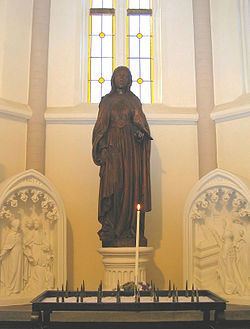Feast October 23 | Name Saint Oda | |
 | ||
Attributes Long blue gown with one bare shoulder; carries a staff or a book; always shown with a magpie on her hand and a crown under her feet Died 726 AD, Sint-Oedenrode, Netherlands | ||
Hymn to saint oda of scotland johannes revisius
Saint Oda of Scotland (c. 680 – c. 726) was a woman, supposedly of Scottish origin, who became a holy woman in the Netherlands. Her feast day is October 23.
Contents

Life
Oda was born blind and her father sent her on pilgrimage to Liège to visit the relics of Saint Lambert. While praying at Saint Lambert's grave she was miraculously cured of her blindness. The miraculous cure of Oda is recorded in Saint Lambert's 8th century vitae. Vowing to dedicate her life to God, she returned to Scotland.
According to records written in the 13th century, her father wanted her to arrange a marriage for her. Because of her vow she fled across the North Sea. After a pilgrimage to Rome and Monte Sant'Angelo sul Gargano, Oda prayed in various villages in the Netherlands and Belgium only to be repeatedly disturbed by magpies. Seeking solitude, she fled from the magpies and the birds led her to the open space in the forest. There the villagers built a hut for her.
In order to protect their humble shelter from the wind, hail, rain and snow and to hide from the view of the world, Oda planted some bushes. The following day they had already grown into a thick hedge.Her father sought for her, and as in the story of St. Dymphna, her location was disclosed by her use of coins from her homeland. However, when he attempted to approach her hut, magpies repeatedly drove him off. Eventually he gave up and returned to Scotland without her. She remained there as a hermitess.
Iconography
Saint Oda is usually depicted wearing a long blue gown with one shoulder bare. She usually carries a staff or a book (symbolic for her cure of blindness). She is always shown with a magpie on her hand and a crown under her feet (symbolic of her rejection of her earthly father's kingdom).
Veneration
After Oda's death, her humble hut became a place of pilgrimage. "Saint Oda's place in the woods" became the town of Sint-Oedenrode, Netherlands (in Dutch, a small manmade open space in the woods is called a 'rode'). Like the flag of Scotland, the flag of Sint-Oedenrode is a white saltire on a blue field.
Pieces of Saint Oda's skull and teeth are kept in the Saint Martin Church of Sint-Oedenrode. Various statues and paintings are kept in a chapel dedicated to Oda in the church's garden. Pilgrims visited Saint Oda for relief of sore eyes and illnesses related to the head.
